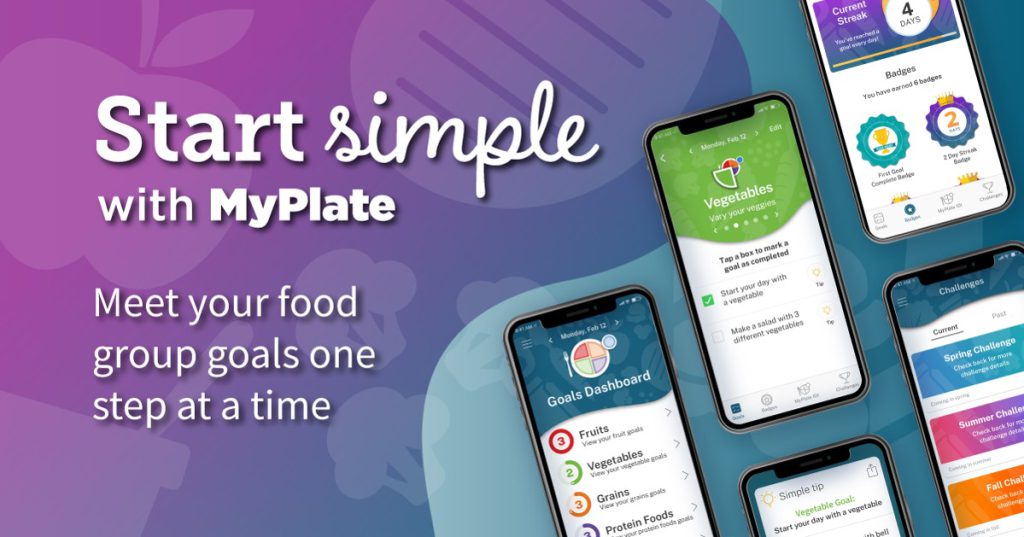Your body needs more than just healthy foods for proper nourishment. Exercising daily, getting plenty of rest and staying hydrated are all essential behaviors for maintaining a healthy body. National Nutrition Month® is an annual campaign created by the Academy of Nutrition and Dietetics.
There are 4 overarching Guidelines in the 2020-2025 edition:
- Follow a healthy dietary pattern at every life stage.
- Customize and enjoy nutrient-dense food and beverage choices to reflect personal preferences, cultural traditions, and budgetary considerations.
- Focus on meeting food group needs with nutrient-dense foods and beverages, and stay within calorie limits.
- Limit foods and beverages higher in added sugars, saturated fat, and sodium, and limit alcoholic beverages.
This year campaign encourages us to try to eat a variety of nutritious food from all food groups.
My Plate
A balance meal is made up to 50% of vegetables and fruits along with whole grains like brown rice or quinoa. The protein portion could be meat or seafood, beans or soy. Add a glass of low-fat milk or a serving of yogurt to complete the meal. You will be exploring everyone of the food groups recommended by My Plate, The Dietary Guidelines for Americans, 2020-2025.
Divided into 5 food groups. The visual guides us as to eating the correct portion sizes
MyPlate was developed to help individuals build an eating plan that works for them.
Fruits group includes all fresh, frozen, canned, and dried fruits and 100% fruit juices. Choose whole fruits rather than fruits juices most often. In general, 1 cup of fruit or 100% fruit juice, or ½ cup of dried fruit is considered 1 cup from this group.
Vegetables group includes all fresh, frozen, canned, and dried vegetables and vegetable juices. In general, 1 cup of raw or cooked vegetables or vegetable juice, or 2 cups of raw leafy greens can be considered 1 cup from the vegetable group. Include a variety of colors and types of vegetables, such as dark green, red, and orange vegetables and beans and peas throughout the week.
Grains group includes all foods made from wheat, rice, oats, cornmeal, barley, and other grains such as bread, pasta, oatmeal, breakfast cereals, tortillas, and grits. In general, 1 slice of bread, 1 cup of ready-to-eat cereal, or ½ cup of cooked rice, pasta, or cooked cereal is considered 1 ounce equivalent from this group. At least half of all grains eaten should be whole grains such as whole wheat bread or pasta, oatmeal and brown rice.
Dairy group includes all milks, including lactose-free or reduced products, fortified soy beverages, yogurts, dairy desserts, and cheeses. Make most choices fat-free or low-fat. In general, 1 cup of milk, fortified soy beverage, or yogurt, 1½ ounces natural cheese, or 2 ounces of processed cheese is considered 1 cup from this group. Foods made from milk that are high in fat and have little or no calcium, such as cream, cream cheese, sour cream, and butter, are not included in this group. These high-fat foods can be eaten in limited amounts occasionally.
Protein foods include all meat, poultry, seafood, eggs, nuts, seeds, and processed soy products. Choose lean protein foods and vary your choices throughout the week. In general, 1 ounce lean meat, poultry, or seafood, 1 egg, 1 tablespoon peanut butter, ¼ cup cooked dry beans or peas, or 2 tablespoons nuts or seeds is considered 1 ounce equivalent
Oils include vegetable, nut and fish oils and soft vegetable oil table spreads that have no trans fats.
The website have multiple areas to explore in three main aspects
- Tools: Get your personalized MyPlate Plan or test your knowledge with our quizzes.
- Resources: Learn all about MyPlate with collections of tip sheets, videos and infographics.
- Recipes: Cookbooks, recipes, videos and more. You can find more information about in https://www.myplate.gov/
Dietary Guidelines for Americans: https://www.dietaryguidelines.gov/
MyPlate: https://www.myplate.gov/
 0
0



